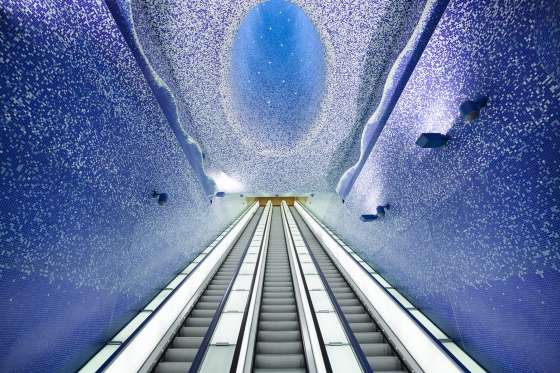Also known as stairs that move, today’s escalator seems as revolutionary a concept as vending machines, barely more exciting than coin-operated pay phones. Slowly and diagonally, they move pedestrians up toward destinations with indeterminate reward—like a second-floor Gap. Frequently central pieces of architecture, escalators climb stories with ease, but they’re often eyesores. A handful of designs, however, take the necessary model to the next level. Practical can be pretty, and worthy of a runway—or at the very least, a stunning step up.

ATOMIUM (BRUSSELS, BELGIUM)
While nothing can beat the exterior of Brussels’ Atomium—originally constructed for the 1958 World’s Fair, it’s designed like a magnified unit cell of an iron crystal—it’d be silly to overlook the beauty of its parts. Metal tubes connect massive spheres and double as pathways, wherein original escalators make lengthy journeys (one of which, just under 115 feet long, was Europe’s longest escalator at the time).

FONDACO DEI TEDESCHI (VENICE, ITALY)
Originally constructed in 1228, Venice’s iconic building Fondaco dei Tedeschi arrived long before the first escalator landed in 1896 (in Coney Island, believe it or not). Commissioned to rework the ancient landmark into a new-age department store, architecture firm OMA articulated a new path through the historic building, dressing the escalator with runway-ready accents: red steps, red trim, and rich wooden paneling.

PUBLIC (NEW YORK CITY)
Ian Schrager’s shiny new Public hotel in Manhattan’s Lower East Side makes an entrance—no surprise for the hotelier known for cofounding Studio 54. Past the ground floor’s revolving doors, escalators designed by Herzog & de Meuron are encased in metal tubes that shoot toward the second-floor lobby. Inside, mirrored surfaces reflect and repeat the golden-orange lights that are piped along handrails, much to the delight of Instagram.

GINZA SIX (TOKYO, JAPAN)
The newest, largest mall in Tokyo’s ritziest shopping district, Ginza Six, leaves no corner without designer edge. The open atrium, designed by Gwenael Nicolas, mirrors the crisscrossed pattern of escalators with angled lattice screens that project the same lines along the perimeter. While each floor’s layout reflects alleyways of Ginza and Kyoto (paths between stores zigzag accordingly), shoppers rise flight by flight to get closer and closer to a hanging Yayoi Kusama installation of red and white pumpkins.

ZOLLVEREIN COAL MINE (DÜSSELDORF, GERMANY)
Not many coal mines reach UNESCO World Heritage status, but Germany’s Zollverein—with a complete network of mining infrastructure, and Bauhaus-style architecture from the Modern Movement—rises to the challenge. Now defunct except for tours, a series of escalators are among the longest outdoor versions of their kind, and are flanked with burnt-orange lighting that vibes with the heat that once radiated in the shuttered mines below.

HUDSON HOTEL (NEW YORK CITY)
It’s not the first time Ian Schrager’s project commanded the limelight. After renovating Hudson Hotel over one decade ago, the design revealed a new doorstep: Through a square concrete opening, a set of escalators are bathed in a buzzy neon-yellow glow that spills straight out and onto the sidewalk.

THE NATURAL HISTORY MUSEUM (LONDON)
Going up, or just passing through? At the Natural History Museum in London, a three-meter Stegosaurus fossil stands at the foot of an escalator that leads to greater heights: Starting in the Earth Hall, the one-way ride shoots straight through the center of a metal globe—a celestial experience, for certain.

TOLEDO STATION (NAPLES, ITALY)
It’s not quite a stairway to heaven, unless heaven is underwater. But Catalan architect Oscar Tusquets Blanca’s Toledo station, part of Naples’ effort to commission illustrious designs by architects and artists, turns this subway station into a permanent art installation. Three illuminated escalators descend 38 meters—dipping below sea level. Surrounded by a scintillating seascape of mosaic tile, the feature is an overhead crater that sparkles with LEDs; a small opening brings a ray of light onto the escalators, down from the town square high above.












